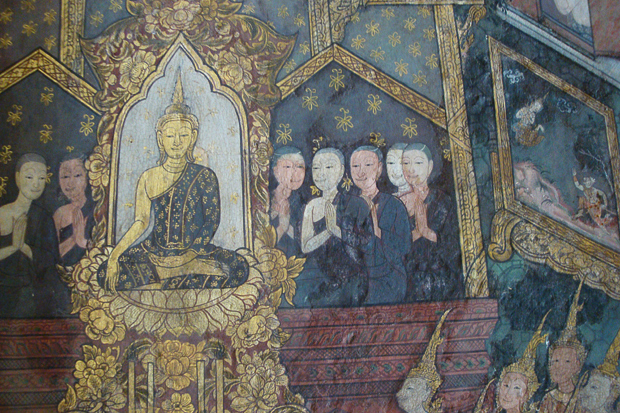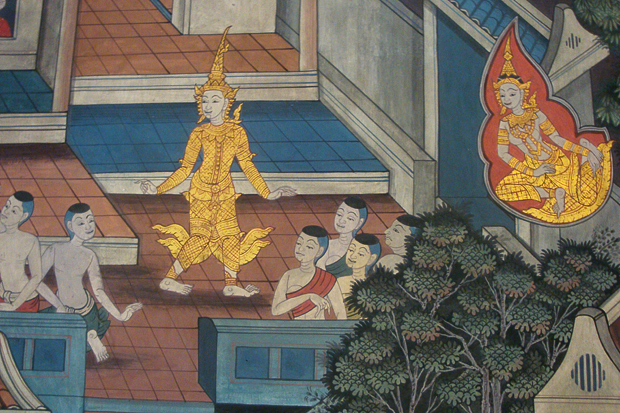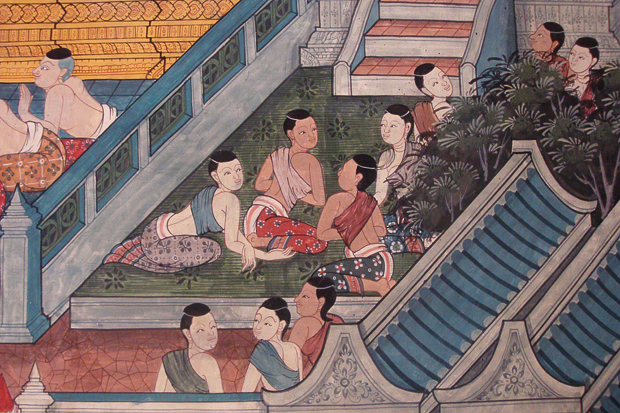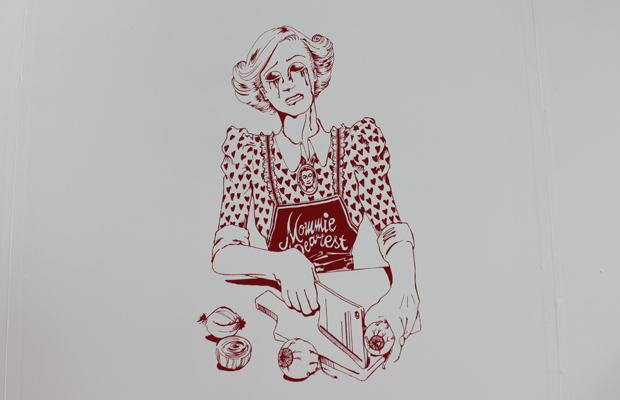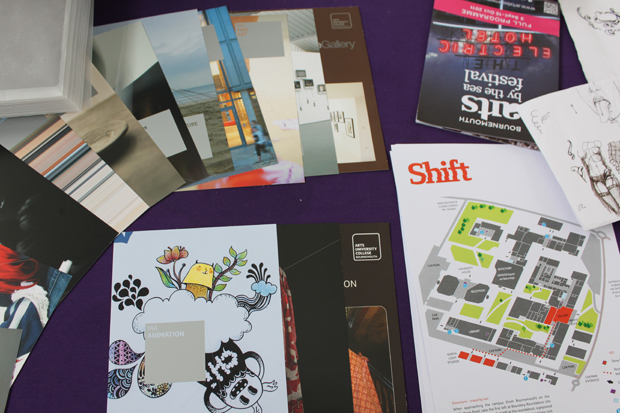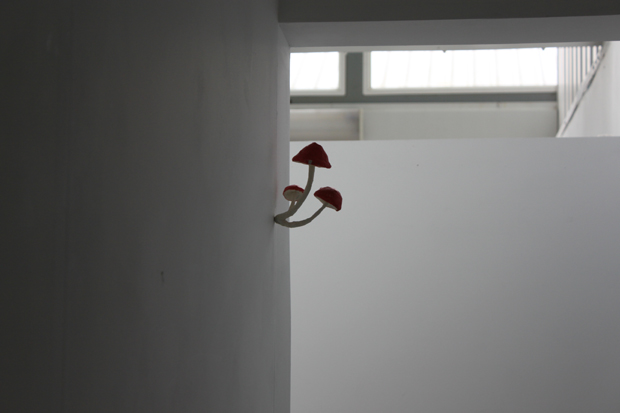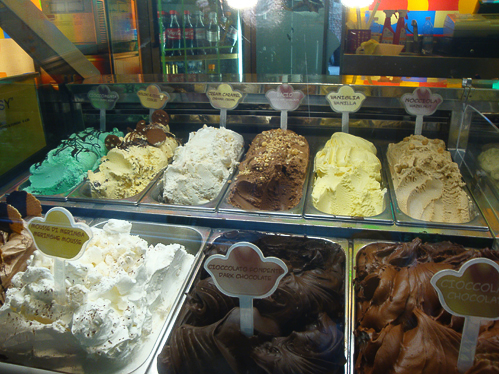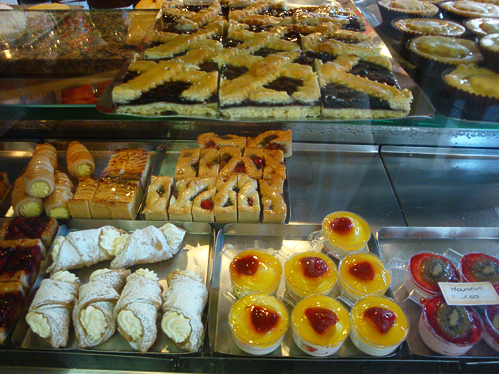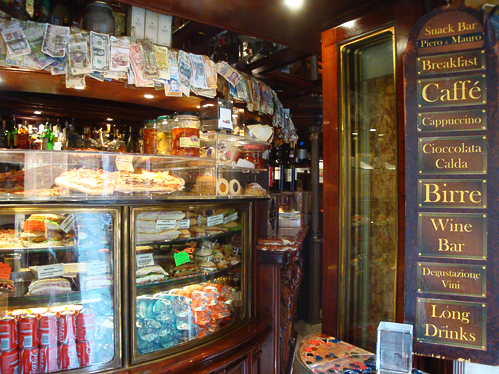Ramkinkar Baij
However it was enlightening to see his growth as a brilliant artist and the extent to which his personal philosophies, politics and ideas were so deeply and honestly entrenched in his work and life. Baij clearly 'lived' his ideals, spending a lot of time with the Santhals who were a prominent topic within his work.
I recently visited NGMA, where they had an exhaustive collection of this artist's work. At first I was skeptical about what was clearly a collection of work from a long ago era of Indian art. Personally, I favor viewing more radical or contemporary works. However it was enlightening to see his growth as a brilliant artist and the extent to which his personal philosophies, politics and ideas were so deeply and honestly entrenched in his work and life. Baij clearly 'lived' his ideals, spending a lot of time with the Santhals who were a prominent topic within his work. His abstract sculptures were a pleasure and my favorites amongst his life's work. His sculptures of animals were brilliant and at times even humorous.
Dog by Ramkinkar Baij, Terracotta, 1950's. 38.5 by 29.5 by 22cm. Image Source: Delhi Art Gallery.
The Poet by Ramkinkar Baij. 1938. Image Source.
Other works worth noting are The Harvest 1957 (oil on canvas), Atomika 1969 (oil on canvas), and a sculpture portrait of Pramod Ganguly (Plaster of Paris).
Gallery Reflexive
Work by Prajakta Palav. It caught my eye because of the way she had used the gallery floor in her work. It is intelligent and relevant, especially in these old buildings in South Mumbai that are converted into gallery spaces.
Prajakta Palav (Dec, 2011). This caught my eye because of the way she has used the gallery floor in her work. It is intelligent and relevant, especially in these old buildings of South Mumbai that are converted into gallery spaces. What I love about this is how the work is almost indistinguishable from the gallery floor at first glance. It makes you sit up and pay attention. Here are some pictures I managed to take from my mobile phone.
Anselm Reyle
His brilliant decorative pieces are brave statements in an art world that so easily dismisses anything that seems 'commercial' or market oriented.
The German artist Anselm Reyle's latest work is being exhibited at Galerie Isa in Mumbai. His brilliant decorative pieces are brave statements in an art world that so easily dismisses anything that seems 'commercial' or market oriented. Titled 'Indian Mylar Vision' the exhibition runs from Dec. 17th 2011 to Feb. 20th 2012 and should not be missed.
Untitled, 2011. Mixed media on canvas, acrylic glass. 143X122X24cm. Indian Mylar Vision, Galerie Isa, Mumbai.
The artist also talks about a topic that is close to my heart - the distinction between design and art and how his collaborations with companies such as Dior question these rigid definitions. 'I find it strange that the intersections between art and design are still so taboo,' he says while introducing his new work. 'Such practice was quite common in the 1920's as the Bauhaus style shows: along with its progression, the antagonism between craftsmen and artists have dissolved - at least for a while. And it did well.'
It is important to point out that art in India does not reject decoration outright. Local craftsmen have played important roles in Indian art today, and there are close links between folk tradition and modern and contemporary art in India.
Reclining Buddha Murals
These are photographs of the detailed murals that decorate the walls and windows of the Reclining Buddha temple. It exists in a much larger temple complex called the Wat Pho, which contains several hundred images of Buddha, many stupas, a huge Bodhi tree, stone statues and smaller temples.
These are photographs of the detailed murals that decorate the walls and windows of the Reclining Buddha temple. It exists in a much larger temple complex called the Wat Pho, which contains several hundred images of Buddha, many stupas, a huge Bodhi tree, stone statues and smaller temples. The scenes narrate the story of Buddha, and remind me of the vast murals in the Ajanta caves which are much older.
From the photos you notice that some parts of these murals look newer than others. I can only guess that these parts have been restored and touched up recently.
Mumbai's First Comic Con
Mumbai's first comic con was crowded and full of enthusiastic fans and artists. I even met several NID alumni and graphic designers, so I'm hoping there will be another one next year. Amongst the notable independent graphic novels being sold, the ones that caught my eye were Hush: A Silent Scream, Twelve: Prelude 0.2, Milk and Quickies and The Itch You Can't Scratch.
Hush by Pratheek Thomas and Rajiv Eipe. Manta Ray Comics, India.
Detail, inside page.
The preview of the book is beautifully illustrated and literally breaks the silence on a socially relevant and taboo topic with a depth of understanding. It gave me so much hope for the future of independent art like this in our cities.
Twelve: Prelude 0.2 by Jasyot Singh Hans and Prabha Mallya. A collection of short stories.
Wonder Bai by Abhijeet Kini, a hilarious series. Others such as Wolver Anna, Angry Moushi etc. were also sold.
Neon Workshop
The neon workshop was a one-day crash course on making neon lights. Detailed demonstrations on how to bend glass tubes, suck out all the air and then fill the tube with either neon, argon or helium took up the first half of the day. The second half was spent exploring the material, after which we were given free reign on the propane blowtorches!! :)
Cutting a glass tube
Glass tubes are bent after careful heating in the right angles, using gravity. Results like this only come after lots of practice.
The ribbon burner has a long flame that softens a large part of the tube evenly.
Joining two glass tubes using a precise burner was extremely difficult. I totally failed at my attempt, I ended up blowing a glass bubble instead because of too much air, and then the bubble burst. A tube with a hole can never be used for neon.
Part of the giant machine that creates a vaccum in the tubes before filling it with the required gases.
Neon master Julia Bickerstaff and British artist Richard Wheater encouraged us to question the limits of the material and explore its potential in relation to our individual art practice. That was the best part, being introduced to a completely new medium and told to freak out with it on the same day. Also worth mentioning was how to transcribe an idea into a drawing for neon-making.
The video below is my work (made by Julia of course) which we filled with helium. I love the colour of helium, its a natural pink hue that went well with the concept, which is the number sixty-nine in Devanagari letterforms. Due to a few impurities added in the tube flickers continuously, an effect that I really really wanted to try out. Another way to do this would be to programme it to flicker. However this is purely physical and does not need any external controls.
The best work was displayed later at the Light Night festival in Bournemouth town center and the Neon: Shaping Light exhibition at the text+work gallery.
Shift Exhibition
Have a look at our post-graduate show Shift. This friday (9th September) is the last day so don't miss it if you're in or around Bournemouth :)
Artist Yi Lu with her paper mache world
Subconscious Form by Shiro Araki
Urban Brick by Bana Toutounjee
by Taro Morimoto
Mumbai/Bombay by Aditi Kulkarni
New Blindness by Rocco Nahas
A stretchable movie by Richard Hurst.
Be-Bee Project by Kaya J. Lee
The Ophelia Project by Samantha Else.
Venice Food
A post on Venice food as promised! So sorry about the huge delay I've been busy with two art shows this month, my post-graduate show and Out Of Sight. Anyway, gelato is the most important food of Venice especially if you're a broke student. I practically lived on it.
Small bakeries are great places to stop when you're lost in Venice and tired after walking for hours.
Pasta at the supermarket in Venice :P
Fucking tiny lasagna. Beware of overpriced and touristy restaurants that serve tiny quantities of food. I paid twelve euros for this!
A chocolate shop :)
 Hotel snacks before our night out. Also don't forget to try lots of Bellini, it's an awesome mix of peach and champagne.
Hotel snacks before our night out. Also don't forget to try lots of Bellini, it's an awesome mix of peach and champagne.
Cafe's are a good place to grab a quick bite of affordable pizza and/or a sandwich when you're on the go, which was most of the time for us since we were obsessed with seeing as much art as possible in six days.
Out of Sight
With an unused underground car park as its gallery walls, Out of Sight investigates the resilience and flexibility of art, and the need for its development with supporting communities in unorthodox circumstances: an appreciation for the otherwise overlooked in the chosen location compliments the political provocation of the role of the outsider in society and rebellion against industry precepts.
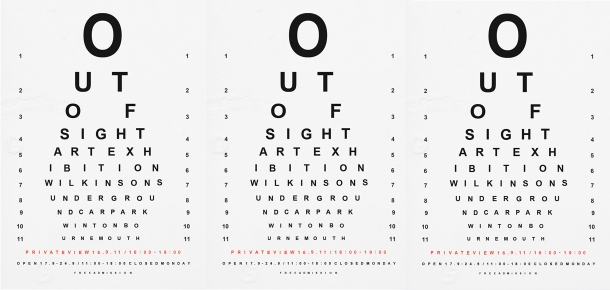 The exhibition Out of Sight is from 17th to 24th of September from 11am to 6pm and will showcase a wide variety of artwork from multimedia installations to sculpture and drawing.
The exhibition Out of Sight is from 17th to 24th of September from 11am to 6pm and will showcase a wide variety of artwork from multimedia installations to sculpture and drawing.
With an unused underground car park as its gallery walls, Out of Sight investigates the resilience and flexibility of art, and the need for its development with supporting communities in unorthodox circumstances: an appreciation for the otherwise overlooked in the chosen location compliments the political provocation of the role of the outsider in society and rebellion against industry precepts.
Below is a video by Michael Compton of day two of the massive clean-up of the dark, unused space.
More on Shadows
In his essay In Praise of Shadows Japanese novelist Tanizaki writes about the conflict between western and eastern aesthetics in the modern world. He says that Japanese 'find beauty not in the thing itself but in the patterns of shadows, the light and the darkness, that one thing against another creates.' He emphasizes beauty in subtlety and that which cannot be seen too clearly, leaving some of the experience to our imagination. Pallasmaa talks of something similar when he emphasizes the importance and intimacy of darkness.
In his essay In Praise of Shadows Japanese novelist Tanizaki writes about the conflict between western and eastern aesthetics in the modern world. He says that Japanese 'find beauty not in the thing itself but in the patterns of shadows, the light and the darkness, that one thing against another creates.' He emphasizes beauty in subtlety and that which cannot be seen too clearly, leaving some of the experience to our imagination. Pallasmaa talks of something similar when he emphasizes the importance and intimacy of darkness:
The eye is the organ of distance and separation, whereas touch is the sense of nearness, intimacy and affection. The eye surveys, controls and investigates, whereas touch approaches and caresses. During overpowering emotional experiences, we tend to close off the distancing sense of vision; we close our eyes when dreaming, listening to music, or caressing our beloved ones. Deep shadows and darkness are essential, because they dim the sharpness of vision, make depth and distance ambiguous, and invite unconscious peripheral vision and tactile fantasy. (Pallasmaa, 1996, p.46).
Pallasmaa continues to say that bright lights kill our imagination whereas twilight, dimly lit spaces and foggy scenes spark our sense of mystery, the mystical and mythological. Tanizaki also mentions this sense of tranquility and calm in shadows, that which separates the inside from the outside:
Whenever I see the alcove of a tastefully built Japanese room, I marvel at our comprehension of the secrets of shadows, our sensitive use of shadow and light. For the beauty of the alcove is not the work of some clever device. An empty space is marked off with plain wood and plain walls, so that the light drawn into its forms dim shadows within emptiness. There is nothing more. And yet, when we gaze into the darkness that gathers behind the crossbeam, around the flower vase, beneath the shelves, though we know perfectly well it is mere shadow, we are overcome with the feeling that in this small corner of the atmosphere there reigns complete and utter silence; that here in the darkness immutable tranquility holds sway. (Tanizaki, 1977).
In my work there is a combination of bright light that hurts the eye and multiple shadows. Parts of the space are brighter and dimmer than others. The views of the city begin with twilight, continue to sunset and then cycle back to twilight in an endless loop. Various kind of shadows are present in the work, those that are glaring and sharp and others that are subtle and noticeable only after an amount of time spent in the space. Due to a feedback loop dim mirror versions of yourself are also visible in the walls, each a mere second after the next. The overall effect is an experience which is disconcerting as you see several shadows of yourself, the other in the walls on either side. Despite bright lights the audience cannot see the entire work because the city is fragmented with shadows. The gaps and shadows leave the final interpretation up to the audience themselves. It is an experience which aims to express the inner conflict of the city, which I call Mumbai.
Reference: Pallasmaa, J. (1996). Eyes of the Skin: Architecture and the Senses. John Wiley & Sons: UK. Sowin, J. (2006). In Praise of Shadows: A Meditation. [online]. Available from:http://www.fireandknowledge.org/archives/2006/09/23/in-praise-of-shadows-a-meditation/ [Accessed 17th August 2011]. Tanizaki, J. (1977). In Praise of Shadows. Leete's Island Books: USA
James Turrell
From 1:14 onwards the video is a walkthrough of Turrell's Ganzfield piece which I experienced at the Venice Biennale. The photographs I took of the space are unable to describe it. The video is better but it fails to express that the space is not tranquil or calm in anyway. Walking to the edge of a room which is indiscernible from the rest of space and realizing there is a 'nothing' beyond it is not a good feeling. This infinity is disturbing - it is completely different from looking up at the night sky. It's an unforgettable experience, but at the same time I didn't want to spend more than five minutes there.
James Turrell 2011. Arsenale, Venice Biennale 2011.
Check out more about the artist James Turrell at Artsy.
Post-Traumatic Urbanism
Cities like Mumbai and Beirut have developed in unstable uncertainty and in many ways are resilient survivors. They have adapted with 'redundant networks' and 'diversity and distribution' rather than 'centralized efficiency' which makes them flexible in the face of shocks to infrastructure (Lahoud, 2010).
Mumbai as a city has undergone several traumatic events in the past few years. Those in my direct memory and experience are the 26/11 attacks and the painfully recent 2011 bombings. Earlier I argued that despite these tragic events the city in essence remained the same. How does a city survive these traumatic events whether they are natural flash floods or terror attacks, and in what way does it change? Today people try to understand how cities survive and evolve through math and science. As a philosophy urbanism states that cities are vitally important to the progress of humanity. In his talk The Surprising Math of Cities and Corporations, West argues that cities are both the solution and the problem, underlining their bipolarity.
And the tsunami of problems that we feel we're facing in terms of sustainability questions, are actually a reflection of the exponential increase in urbanization across the planet... However, cities,despite having this negative aspect to them, are also the solution. Because cities are the vacuum cleaners and the magnets that have sucked up creative people, creating ideas, innovation, wealth and so on. So we have this kind of dual nature. (Geoffrey West, 2011)
West explains why cities are so successful when he says 'You could drop an atom bomb on a city, and 30 years later it's surviving. Very few cities fail.' Mumbai as a city has survived several traumatic events over the past two hundred years, though nothing on such a catastrophic level. It is an ancient place that has been ruled by a succession of invaders. There is even evidence that suggest that the islands have been colonized by humans since the Stone Age. Each event in this recorded and unrecorded past have changed the landscape and its people, but I am most interested in its recent traumas.
So cities are extremely successful, bipolar creatures. But how do traumas affect them? Philosopher and critical theorist Andrew Benjamin says that 'trauma involves a more complex sense of place.' He proposes that the city contains forgotten and repressed settings that are beyond memory but always present, creating an 'estrangement' and sense of the 'unaccustomed' when such events return.
The term 'post-traumatic' refers to the evidence of the aftermath - the remains of an event that are missing. The spaces around this blind spot record the impression of the event like a scar. (Lahoud, 2010. p.19).
Cities like Mumbai and Beirut have developed in unstable uncertainty and in many ways are resilient survivors. They have adapted with 'redundant networks' and 'diversity and distribution' rather than 'centralized efficiency' which makes them flexible in the face of shocks to infrastructure (Lahoud, 2010). When it comes to events like the most recent bomb attack in 2011, the city picked up the pieces and went on the next day as if nothing had happened. Local trains continued to run. The event was given its significant narrative by the media and the places that were bombed were cleared up. Memories and the gaps created by such violence will always remain an intrinsic part of the city's architecture. But it is Mumbai's impenetrable resilience in the face of such catastrophes that fascinates me. Events such as 9/11 in a first world country completely derailed the city, but in Mumbai it was in many ways business as usual. But forgetting like we do in Mumbai does not erase the hurt.
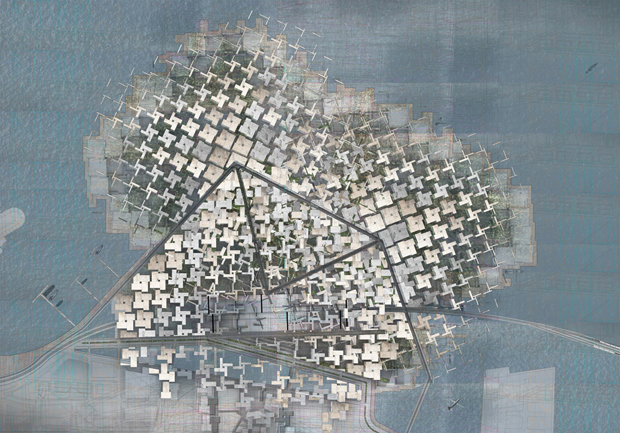 The Diversity Machine and Resilient Network, 2009. Social Transformation Studio. Martin abbot, Georgia Abbot, Clare Johnston, Joshua Lynch and Alexandra Wright.
The Diversity Machine and Resilient Network, 2009. Social Transformation Studio. Martin abbot, Georgia Abbot, Clare Johnston, Joshua Lynch and Alexandra Wright.
Anthony Burke says that the reason cities are so difficult to predict is that they are very complex systems 'growing at the edge of chaos.' Even small events can lead to avalanche-like conditions because both natural and human-made catastrophes display a self-organizing criticality or the:
...tendency of large systems with many components to evolve into a poised, `critical' state, way out of balance, where minor disturbances may lead to events, called avalanches, of all sizes. Most of the changes take place through catastrophic events rather than by following a smooth gradual path. The evolution to this very delicate state occurs without design from any outside agent. The state is established solely because of the dynamical interactions among individual elements of the system: the critical state is self-organized. Self-organized criticality is so far the only known general mechanism to generate complexity. (Per Bak, 1997, p.1).
The idea that a city is on the verge of chaos is not far from many narratives in western popular culture. The accepted line is that just one push is enough to bring the whole system crumbling down. However the theory above is not as simple as that, these systems are large and therefore extremely difficult to destroy completely. Its heartening to see that even human cities are in the end, part of nature, and follow patterns similar to natural phenomenon such as weather.
Although there are no definitive answers to what post-traumatic urbanism is the term itself raises critical questions and discussion. An often quoted statistic today is that the urban world is larger than the rural world, which underlines the importance of trying to understand urban trauma and its effect on the city and its people. In my journey to capture the essence of Mumbai, to explore unexpressed feelings of conflict created by repressed events and resolve my own perceptions and experience; it is this complexity which is central to understanding my art.
Reference: Benjamin, A. (2010). Trauma within the Walls: Notes towards a philosophy of the city. Architectural Design. Vol. 80. No.5. pp.24-31. Burke, A. (2010). The Urban Complex: Scalar probabilities and Urban Computation. Architectural Design. Vol. 80. No.5. pp.87-91. Lahoud, A. (2010). Post Traumatic Urbanism. Architectural Design. Vol. 80. No.5. pp.14-23. Per Bak. (1996). How Nature Works: The Science of Self-Organised Criticality. Copernicus Press: New York. West, G. (2011). The Surprising Math of Cities and Corporations. [online]. Available from http://www.ted.com/talks/geoffrey_west_the_surprising_math_of_cities_and_corporations.html [Accessed 2nd Aug. 2011].
Nico Vascellari
The artist and musician creates sound and light installations that center around themes of nature, spaces, and spiritualism. His work at the Biennale interested me because of his use of shadow, especially the way the audience's shadows are incorporated into projected slides of his collage work. The experience is amplified by a loud sound every time the slide physically changes since an old world projector is used.
Nico Vascellari. Untitled Horizons, 2011. Collage on Paper 120 slides, three slide projectors. Dimensions variable. Courtesy of Bugada & Cargnel, Paris. Photo by Aditi Kulkarni, Venice.
Reference: Bugada and Cargnel. 2011. Nico Vascellari. [online]. Available from: http://www.bugadacargnel.com/en/pages/artistes.php?name=21891. Accessed 21st June 2011.
Dayanita Singh
I am especially interested in her attempts to express her own visions of a place or city, opposing the singular story people usually expect about India, that of 'sensational catastrophes and human failures'
Phil mentioned Singh in connection to my work on Mumbai because of her series of photographs titled Dream Villa. Her landscape images of Mumbai resonate with the kind of video I'm using for my installation. I am especially interested in her attempts to express her own visions of a place or city, opposing the singular story people usually expect about India, that of 'sensational catastrophes and human failures' (Cotter, H. 2005). Dream Villa 11. 2008. Dayanita Singh [Image Source]
House of Love 2010. Dayanita Singh. [Image Source].
Reference: Cotter, H. 2005. Objects of Repose and Remembrance. New York Times. [online]. Available from: http://www.nytimes.com/2005/03/30/arts/design/30cott.html?ex=1172638800&en=840b508f152bce9e&ei=5070 Date Accessed: 21st July 2011.
Degen, N. 2008. Dayanita Singh. Frieze Magazine. [online]. Available from: http://www.frieze.com/shows/review/dayanita_singh/. Accessed: 21st July 2011.
Dayanita Singh: House of Love. La Lettre. [online]. Available from: http://lalettredelaphotographie.com/entries/dayanita-singh-house-of-love. Date Accessed: 7th August 2011.
Danger of a Single Story
This brilliant TED video by novelist Chimamanda Adichie articulates what I often have to say about Mumbai while here in UK. Namely, yes there is poverty and yes we have slums - but these are proud people who are more than just the anonymous poor.
This brilliant TED video by novelist Chimamanda Adichie articulates what I often have to say about Mumbai while here in UK. Namely, yes there is poverty and yes we have slums - but these are proud people who are more than just the anonymous poor. They don't want your useless pity. When I make art about Mumbai I often have to defend my work and my position to outsiders because it is not the typical vision of what people imagine Mumbai to be, which is terrible disparity and nothing else. She is also quick to point out however, that all of us have at one point or the other indulged in a 'single story.' Whats important is to be aware of it and avoid it as much as possible.
Berry Bickle
Although I visited and enjoyed several exhibitions at the Venice Biennale, very few truly touched me emotionally. A work of art in an exhibition rarely provokes very strong feelings because you're prepared for it. Especially if you're an artist or if you frequent art galleries. You're about to enter a gallery or studio space so you know you're going to see something weird, different or even shocking. So if it is shocking, its at a bearable and sometimes dismissive distance. A truly powerful artist breaks through this mental shield we have and gets under your skin. Berry Bickle's video installation Ze had me rooted to the spot for several minutes. Here are two video stills from the Zimbabwe pavilion catalogue: Ze, 2011. Video Still. DVD Pal 9 min. Courtesy: Berry Bickle.
Ze, 2011. Video Still. DVD Pal 9 min. Courtesy: Berry Bickle.
The video still below from her website interested me because of her use of shadows, video and projection to create multiple versions of the same person. This is similar to my final installation being set up this month, where I use this method to create doubles.
between moment RED, Video Still. Berry Bickle.
Reference: Bickle, B. 2011. Seeing Ourselves. Zimbabwe Pavilion: Venice
Collaboration: The Third Hand
Through collaboration the singular voice of the artist is muted or dispersed, it is a break away from a singular artistic identity. The author introduces the idea of a 'third hand,' or ghost artist which is an elusive other or combined identity created in collaborative works. This third independent existence is in itself 'uncanny' because such a constructed ghost identity 'blurs the distinction between the real and phantasmic.'
[A summary of ideas from the book The Third Hand - Collaboration in Art from Conceptualism to Postmodernism].
The book focusses on a period of western art history during the 1960's and 1970's which the author identifies as the beginnings of artist collaboration, a conscious movement away from individual lone artists making work in a conventional studio. He describes and classifies three kinds of collaborative artist teams. What most interested me in the discussion of the meanings and motivations behind various types of collaboration, was the issue of identity.
Through collaboration the voice of the artist is muted or dispersed, it is a break away from a singular artistic identity. The author introduces the idea of a 'third hand,' or ghost artist which is an elusive other or combined identity created in collaborative works. This third independent existence is in itself 'uncanny' because such a constructed ghost identity 'blurs the distinction between the real and phantasmic.'
The author's discussion of the uncanny helped me better understand my previous collaborative project Tobari No Akari 2. Using dolls, dream-like doubles and shadow doubles the images we created are surreal and uncomfortable, bringing forth memories from childhood but in a disconcerting way. We could also say that creating ghost doubles in the installation references the joint artistic will of the collaboration and work itself.
The video shown below is an attempt to document the collaborative process where we arranged and re-arranged the installation over several hours. It highlights the importance of collaboration as a method of creating more avenues of future work; as well as the potential for it to be a work of art in terms of performance.
The author also talks about artists that use collaboration as a means to escape personal limits and language, to travel beyond conventional authorship and representations of identity, or a 'relativisation and reformation of self.' I felt this was especially relevant to the motivation behind my collaborative projects; however I hesitate to deconstruct or over-explain the experience for fear of losing sense of its meaning and to some extent, its mystery.
Shift
Shift the post-graduate show will be held at the Arts University College Bournemouth from 2nd to 9th September, open from 10am to 4:30pm daily. Entry is free. The show will be open for a late night viewing on the 8th (Thursday) and is closed on Sunday.
 Shift the post-graduate show will be held at the Arts University College Bournemouth from 2nd to 9th September, open from 10am to 4:30pm daily. Entry is free. The show will be open for a late night viewing on the 8th (Thursday) and is closed on Sunday. The Facebook page is here.
Shift the post-graduate show will be held at the Arts University College Bournemouth from 2nd to 9th September, open from 10am to 4:30pm daily. Entry is free. The show will be open for a late night viewing on the 8th (Thursday) and is closed on Sunday. The Facebook page is here.
Don't miss it! The exhibition will showcase the work of post-graduate students in Animation, Contemporary Performance, Graphic Design, Interactive Media, Costume, Fashion, Fine Arts and Photography. The work will reflect the multidisciplinary nature of the post-graduate course here at AUCB, and each student's individual pathway.
Stay tuned for more updates on the show. And if you can't make it don't fret, I will be posting photos and videos of the awesome event :)
Update: Photos and videos here.
Site-Specific Art
In his book Eyes of the Skin, Pallasmaa talks at great length about the beauty of human perception and how the senses interact with each other to form experience. He emphasizes the importance of a sense experience as a whole. He says there is a bias to the eye in the architectural practice because people are focussed on how a building looks rather than how a body can move within it or how it feels. When it comes to the perception of places he discusses the importance of emotion, memory, imagination and fantasy.
During my research into place-making in phase two I briefly discussed the rigidity of a panoramic city view and my attempts to break it by framing unfamiliar cityscapes, using shadows and through collaboration. The book is relevant to my studies because it discusses creating place, the transitive nature of site, framing and virtual and 'real' spaces. The author describes monuments as loci's of power and authority (Kaye, 2000) in his chapter on Performing the City. This underlines the rigidity of the panorama since monuments are an iconic part of them. A relevant example is Mumbai's famous Nariman Point which is named after a historical Congress party leader and contains Indian and international financial institutions and government buildings such as CBI, RBI, Mittals, Birla's, JP Morgan, Merrill Lynch, Vidhan Sabha etc.
Monumentality […] always embodies and imposes a clearly intelligible message. It says what it wishes to say - yet it hides a good deal more: being political, military and ultimately fascist in character" (Lefebvre, 1991 cited in Kaye, 2000, p. 34).
He also discusses the relation between the body and the city or built environment and the body and the space, which in this case is the installation space in artist Wodiczko's work. A completely artificial and constructed installation is also a built environment. People interact with the architecture of the city, and similarly the audience interacts with the architecture of installation. The artist says that 'Our position in society is structured through bodily experience with architecture' (Wodiczko, 1992 cited in Kaye, 2000, p. 38).
In the installation test below, the audience directly affects an abstracted view of the city. In this constructed space people can directly change and affect an image of the architecture, making it fluid and interchangeable.
The author says 'where the site functions as a text perpetually in the process of being written and being read, then the site-specific work's very attempt to establish its place will be subject to the process of slippage, deferral and indeterminacy in which its signs are constituted' (Kaye, 2000, p. 183).
Further reading lead me to Merleau-Ponty's theories of phenomenology and perception where he discusses the essence of perception and experience. He says that we cannot separate our minds and bodies from our perception of the world, or in other words that we are 'condemned to meaning' (Merleau-Ponty, 1962, p. xxii). In his book the Phenomenology of Perception he discusses the relationship between reflective and unreflective experience, psychological and physiological aspects of perception, and consciousness as a process that includes feeling and reasoning.
We must not, therefore, wonder whether we really perceive a world, we must instead say: the world is what we perceive. (Merleau-Ponty, 1962, xviii).
In his book Eyes of the Skin, Pallasmaa talks at great length about the beauty of human perception and how the senses interact with each other to form experience. He emphasizes the importance of a sense experience as a whole. He says there is a bias to the eye in the architectural practice because people are focussed on how a building looks rather than how a body can move within it or how it feels. When it comes to the perception of places he discusses the importance of emotion, memory, imagination and fantasy:
We have an innate capacity for remembering and imagining places. Perception, memory and imagination are in constant interaction; the domain of presence fuses into images of memory and fantasy. We keep constructing an immense city of evocation and remembrance, and all the cities we have visited are precincts in this metropolis of the mind. (Pallasmaa, 2005, p.67).
In my attempts to create a feeling of conflict within the city, a subtle realization of the bipolarity within Mumbai, the result was a space that could not be expressed as a still image. Not could it be expressed by only video. By adding a third dimension of time and motion, where the audience themselves make the image change and break the city is read as something in constant flux.
I know myself only in my inherence in time and in the world, that is, I know myself only in ambiguity. (Merleau-Ponty, 1962, p.402).
Reference: Kaye, N. 2000. Site-Specific Art: Performance, Place and Documentation. Routledge: London Merleau-Ponty. 1962. Phenomenology of Perception. Routledge: London. Pallasmaa, J. (2005). Eyes of the Skin: Architecture and the Senses. John Wiley & Sons: UK. View Wodiczko's Bio & Work in detail.
















